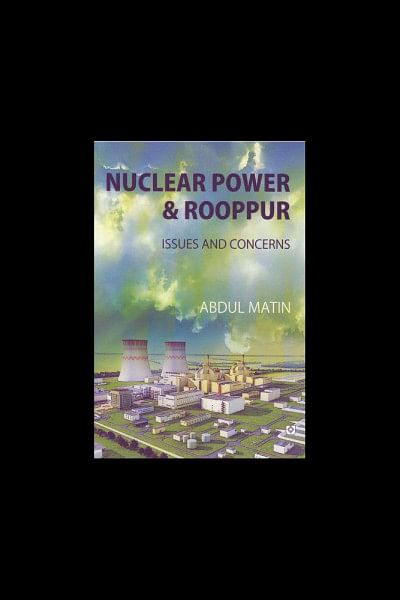Decoding Rooppur...

In the opening, the book printed by Madhyama Media and Publications points to the fact that publishers in this country – though slowly but are finally becoming skilled. Hat's off to the publisher.
The quest for setting up a nuclear power plant in Bangladesh's Rooppur is even older than the country's independence. In the book nuclear power and Rooppur a number of key issues have been discussed to evaluate the need, benefits, risks and problems on whether Bangladesh can afford to run a nuke plant. Undeniably, on the subject of the proposed power plant in Rooppur, no one that I know of, has written and published as much as Dr.Abdul Matin. His dazzling career as an atomic engineer and specialist bestowed him with in-depth knowledge of nuclear plants. But while going through the chapters he reminded this reviewer of that old saying – 'You must continue to gain expertise, but avoid thinking like an expert.'
Divided in two parts the book contains a total of 33 chapters but unlike a work of non-fiction the ordinary reader may get bored to finish it by beginning to read from start till end. It's sensible to select the chapters specifically as their content is clearly chalked out. Also some chapters have technical details of nuclear power generation that may sound puzzling but then again that's what differentiates the expert's opinion from the ordinary.
This reviewer may not be a student of science but some chapters had spawn cravings to learn more of nuke based energy producing. However, it's the arguments, for and against the plant in Rooppur that have always fascinated me. Chapters 4, 12, 13, 20 and 33 are well explained for the arguments but it's also the history behind the plant that, in all probabilities, may catch the reader's attention.
Core strength of the book is, so many aspects encompassing the proposed power plant in Rooppur have been discussed, that it can undeniably serve as a checklist guide when a new feasibility study is required. Moreover, it's also a SWOT analysis from a business perspective where the profit margins are missing. However, the intention was never to write it to serve as a business plan.
Two chapters ( 8 and 23) drawing lessons from the Fukushima disaster have complimented and added more value to security and safeguard related issues. Chapters 2 and 3 may help the reader to know more about the various types of nuclear reactors including the most advanced ones. Environment and biological effects of nuclear power generating have been argued with facts too.
Some chapters were known beforehand as they were published in a daily newspaper but a compilation has brought those pieces together. Nevertheless, the point this reviewer wants to make is: how seriously will this research based work be taken? Or will it be - 'just another reference book on the shelf'?
Apart from just collecting the book, the concerned atomic energy authorities can also use its author's knowledge in practicality. Since, ins and outs of an entire nuclear plant can't be simply written off within 131 pages, so I assume, Mr.Matin will have more to say on Rooppur issue.
In a country where retired experts are more often neglected than taken seriously – all possibilities are there - for the book to meet its ultimate demand.
There are nations which meet more than 30 to 60% of their power requirements through the nuclear power system, but Bangladesh's reality is far different from theirs. It neither has manpower nor expertise. Considering at least these two facts, publishing of it was essential. In fact, had it been published a couple of years ago some time before our Prime Minister's visit to Russia in 2013 it would have done more good.
Also after the Fukushima disaster a number of plants across the globe were shut down while some countries have reduced their dependence on nuclear generated power but yet, so much potential of nuclear energy is still to be discovered.
As long as nuclear plants function there will be flaws, weaknesses in them. Innovations are needed for safe and hazard free nuclear power generation.
Ban Ki-moon's once said – "Nuclear power plants must be prepared to withstand everything from earthquakes to tsunamis, from fires to floods to acts of terrorism." I don't quite agree with this declaration. If we think in tune with the UN general secretary's statement then we may have to attempt to build an 'indestructible nuclear plant'.
Which I don't know, how feasible and practical may be especially, all power plants, including nuclear, have a finite economic life. A chapter consisting of opinions from foreign experts would have made the book's inevitability more. We expect to see it on the second edition. Despite publisher's hard work there exists several printing mistakes in the book. Luckily, an erratum has been prepared by the author that is likely to be attached to the hard copies and also available via request from the author.
Priced at Taka 595 the book comes with a set of useful tables, statistics and tables.
The reviewer is a journalist

 For all latest news, follow The Daily Star's Google News channel.
For all latest news, follow The Daily Star's Google News channel. 



Comments